Abstract
Pakistan’s water quality and water management are at a crucial juncture, especially in the underdeveloped province of Baluchistan. The fifth most populous country, which ranks fifth in the global climate vulnerability index, confronts evolving water security challenges, which are complicating its national security matrix. Water shortages are escalating swiftly due to increasing demand across all sectors that utilize water. The burgeoning population, increasing from 175 million in 2010 to an estimated 247 million in 2025, and the adverse impacts of climate change are seriously affecting water quality and availability. This is exacerbated by persistent political instability and internal security issues, disincentivizing potential investors in the water sector in Pakistan in the short to medium term. The quality of water for drinking purposes is declining fast due to scarcity and contamination from various sources. The political promise of ensuring safe drinking water for the residents of Baluchistan remains an election slogan due to the persistent disparity between promises and implementation. The study involves a physical examination of water samples collected from various sectoral geographical zones of Baluchistan in the laboratory testing process to ascertain the quality of water. To develop a comprehensive picture, the samples were collected from both rural and urban areas in designated zones, ensuring that samples were representative of the entire province. In the last stage of the investigation process, the sample results have been compared with minimum safe standards instituted for drinking water by national and international organizations. Laboratory testing results indicate a significant decline in the quality of drinking water in Baluchistan; in most cases, the samples could not meet the permissible safe ranges outlined in Pakistan’s National Quality Standard (NQS) framework for drinking water and WHO guidelines. The persistent decline in water quality and water availability poses serious challenges to the attainment of UNSDG number 6 regarding the provision of clean drinking water to the inhabitants by 2030. The study provides incisive analysis and actionable recommendations as a policy input to facilitate relevant ministries and organizations in mitigating the vulnerabilities of climate change, providing clean drinking water to inhabitants of Baluchistan, and addressing critical issues of water sustainability in Baluchistan as an evolving national security challenge.
1. Introduction
Water security is an evolving national security challenge for Pakistan. Notwithstanding the availability of adequate water for different sectors like drinking, irrigation, domestic, and industrial usage, the quality of drinking water is also witnessing continuous decline due to multiple factors investigated in this study. Pakistan is a signatory of UNSDGs with the attainment year 2030, which is fast approaching. SDG number 6 pertains to the provision of clean drinking water [1] to the inhabitants of Pakistan, which is currently facing serious challenges. With the burgeoning population estimated to be 247 million in 2025 [2], Pakistan is seriously impacted by climate change and ranks 5th on the climate vulnerability index [3], which has profound implications for the water availability, quality, and distribution system. Contaminated water has emerged as a pressing challenge in Pakistan, attributable to multiple sources [4]. The primary reasons are the elevated temperatures, which raise the heat levels, and the existence of organic compounds like microorganisms, heavy metals, and nutrients [4]. Water contamination in Pakistan arises from geological and natural factors, including chemicals, herbicides, coal mining processes, pesticides, oil refining, and inappropriate disposal of wastewater polluting groundwater with septic tank leakages [5]. There is an imbalance between the future availability and demand of water in Pakistan, which is transiting to a water-scarce country beginning from the year 2025, creating water security as an evolving national security challenge due to contamination of ground and surface water alike, as indicated in Figure 1 [6]. Moreover, the per capita supply of water is also declining rapidly, pushing Pakistan from a “water-stressed” country at the end of the year 2024 to a “water-scarce” country at the start of the year 2025 [7]. This poses serious challenges due to fewer rains in the last eight months, pointing towards an impending drought-like situation if the ongoing dry spell does not improve in the coming monsoon season in June/July 2025 [7]. Figure 1 indicates water availability and demand by the year 2025.
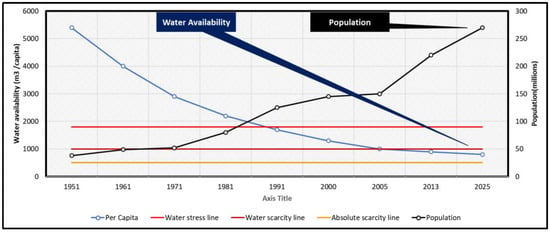
Figure 1.
Pakistan’s Water Availability and Demand Projection.
The evolving situation presents numerous challenges for the residents, who are heavily reliant on agriculture for employment and food security, hence exacerbating human security concerns, especially in the province of Baluchistan [8]. It adversely affects energy-producing companies reliant on hydrological methods. The contamination of water in Pakistan has reached a critical level, as approximately 80% of inhabitants are compelled to consume contaminated water, while merely 20% have the luxury of safe drinking water [9]. Climate change is also adversely impacting water availability and quality, especially in the province of Baluchistan, where data from the years 2022 to 2024 reveal changes in the precipitation patterns causing heavy floods and droughts in the same year from 2022 to 2024. The map data produced by the Pakistan Metrological Department for the year 2023 [10] are shown in Figure 2 to build the context of evolving climatic variations.
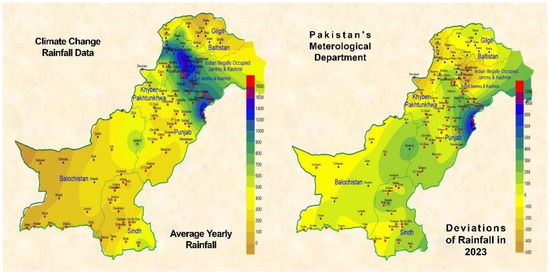
Figure 2.
Pakistan’s Climate Change Rainfall Data—Metrological Department.
A review of the existing literature on water resources management indicates that 97.5% of the earth’s surface is covered by saline water [11], which is found in oceans, while freshwater constitutes 2.5%, out of which less than 1% is accessible for use [12]. Secondly, an additional difficulty is the unequal delivery of accessible freshwater worldwide due to natural systems, which, in contrast to the global population distribution, significantly affects water availability in Pakistan. Approximately 785 million individuals worldwide lack access to clean drinking water, with around 100 million in Pakistan at risk of consuming contaminated water [13]. Approximately 70% of the population in Pakistan consumes contaminated water, resulting in the annual death of around 53,000 children under the age of five years due to the use of contaminated water [14]. The sources of groundwater in Pakistan are shown in Figure 3, which indicates that the main sources of recharge are rain and canal leakage, which, if not preserved well, can have potential contamination effects.

Figure 3.
Pakistan’s groundwater status compiled by authors from different sources.
Water quality assessment methods often include chemical and physical differences caused by factors such as eroded bedrock, sedimentation, detergents, temperature runoff, pesticides, and hydrogen ion concentration (pH). The primary difficulty concerning global water quality is the presence of eutrophication, which is demonstrated by increased concentrations of lead (Pb) particles and phosphorus (P) presence in water, which contaminates it and poses risks to public health. Water contamination, compounded by scarcity, has emerged as a critical national security issue for Pakistan [15].
The study investigates Baluchistan’s water resources and their distribution among the districts and different sectors for daily usage and agriculture production. The results of water quality laboratory tests covering all the geographical regions of Baluchistan have given a clear insight into the impending health risks of the use of contaminated drinking water, especially in the rural areas of Baluchistan, which is an alarming trend. The samples tested through the laboratory indicated that most samples exceeded National Environmental Quality Standards (NEQS) [16] and the World Health Organization (WHO) recommended thresholds [17]. Comprehensive recommendations are presented in the last part of the study to facilitate the relevant ministries and departments through structured feedback for achieving water-related sustainable development goal number 6 by 2030, which is reproduced here [1]:
- ➢
- “6.1 By 2030, achieve universal and equitable access to safe and affordable drinking water for all
- ➢
- 6.2 By 2030, achieve access to adequate and equitable sanitation and hygiene for all and end open defecation, paying special attention to the needs of women and girls and those in vulnerable situations
- ➢
- 6.3 By 2030, improve water quality by reducing pollution, eliminating dumping and minimizing release of hazardous chemicals and materials, halving the proportion of untreated wastewater and substantially increasing recycling and safe reuse globally
- ➢
- 6.4 By 2030, substantially increase water-use efficiency across all sectors and ensure sustainable withdrawals and supply of freshwater to address water scarcity and substantially reduce the number of people suffering from water scarcity
- ➢
- 6.5 By 2030, implement integrated water resources management at all levels, including through transboundary cooperation as appropriate”
The study was conducted in the province of Baluchistan by dividing its landmass into geographical regions with the aim of covering every region, including rural and urban areas alike. The study is spread over the entire year of 2024, covering all four seasons, where samples from designated sampling sites have been tested and retested in the laboratory to ascertain their quality for drinking purposes. The objectives of the study are, but are not limited to, the following:
- ➢
- To examine the status of water in Pakistan in general and Baluchistan in particular.
- ➢
- To investigate the quality of water for drinking purposes in Baluchistan.
- ➢
- To analyze water conservation, distribution to different sectors, and recycling of wastewater for use in agriculture and washing purposes.
- ➢
- To recommend measures as policy feedback to relevant ministries and organizations for ensuring water security and achieving UNSDG number 6 by 2030
The core argument states that “the quality of drinking water in Baluchistan is contaminated, causing several health risks and a major impediment to the attainment of UNSDG number 6 by 2030”.
The study provides empirical answers to the following research questions:
- ➢
- What are the water security challenges in Baluchistan?
- ➢
- How does contaminated water quality impact the inhabitants of Baluchistan?
- ➢
- How can the rational distribution of water to different sectors be made to ensure water security on a sustainable basis?
- ➢
- How can conservative measures help Baluchistan’s long-term water security?
The study is limited to the province of Baluchistan. Very little literature is available on water quality in Baluchistan, and results of laboratory tests on water quality are non-existent. Despite geographical difficulties, the authors have conducted exhaustive field visits to designated geographical regions of Baluchistan and conducted laboratory tests during the entire year 2024.
The impact of climate change on water quality and sustainability in Baluchistan is a unique and novel undertaking successfully completed by the authors. The effects spread over the year 2024, during all four seasons, and in every geographical region of Baluchistan. Our work is the first of its kind and focuses on the quality of drinking water and availability of water for different sectors of Baluchistan with a view to identifying challenges in meeting UNSDG number 6 by 2030. Although the Pakistan Water Research Council (PCWR) is mandated to investigate the water quality across Pakistan, they have performed a good job in conducting water testing from different regions. Their guidance and consultation were of immense value in completing this study. It is highlighted that this is the first study to encompass samplings and ascertain drinking water quality across the entire Baluchistan. The rider clause revolves around UNSDG number 6 for the provision of clean and safe drinking water for the inhabitants of Baluchistan. It is appreciated that this study sets the pace as a foundation document, and subsequent researchers will build on from here and contribute to the water security of Baluchistan and Pakistan on a sustainable basis.
Literature Review
The existing literature amply covers the ongoing impacts of climate change on different sectors of Pakistan, especially water availability and water quality. However, very little literature is available on Baluchistan. The methodology of systematic literature review (SLR) was adopted, which helped in conducting an incisive analysis of past research to identify the research gap on water security in Baluchistan and, broadly, in Pakistan as a whole. The growing population and lessening of water resources compounded by the impact of climate change have complicated Pakistan’s water security matrix [18], posing it as an evolving national security challenge, impacting human security across multiple dimensions [19]. The glaciers of Pakistan, especially in the Himalayas and Karakoram ranges, are undergoing rapid melting because of increasing temperatures, which have the potential for glacial lake outburst floods (GLOFs), which Pakistan has been regularly experiencing for the past four years and altered river flows that impact millions reliant on glacial meltwater for agriculture and potable water [20]. Alterations in precipitation patterns and glacial melt resulting in the atypical drought observed during the years 2022 to 2024 have considerable ramifications on Pakistan’s limited water supplies [21]. The visible impacts of climate change are the unpredictable rain patterns that affect the harvesting seasons. The intensification of water scarcity, especially in semi-arid and arid regions, results in reduced agricultural output, and possible disputes over water distribution across provinces have become more pronounced [22]. Climate change correlates with a rise in the frequency and severity of extreme weather phenomena, including floods, droughts, and heat waves. The catastrophic effects of these occurrences on communities, infrastructure, agriculture, and livelihoods are intensifying poverty and food insecurity [23]. The agricultural industry of Pakistan, an essential element of its economy, is significantly vulnerable to the effects of climate change. The fading crop yields, alterations in cropping patterns, heightened insect infestations, and animal losses owing to changing climatic conditions are jeopardizing food security and rural livelihoods [24]. Environmental degradation produced by climate change, including water scarcity, flooding, and land dilapidation, is driving internal displacement and migration in Pakistan. The evolving situation is causing socio-economic difficulties encountered by displaced populations, such as the loss of livelihoods, social tensions, and strain on urban infrastructure and services [25]. Climate change is also impacting public health, such as heat stress and vector-borne infections. The rising incidents of heat-related illnesses, waterborne diseases, malnutrition, and mental health disorders exacerbate existing health inequities. Climate change has significantly affected water quality in Pakistan, particularly for drinking purposes [26]. Climate change presents substantial problems to water governance in Pakistan, which signifies that the water consumption per unit of GDP is the greatest in the world, reflecting an exceptionally low level of productivity and efficiency [27]. Insufficient water reservoirs, inefficient water management in agriculture and domestic settings, limited wastewater recycling, and the pollution of potable water have emerged as significant health hazards, posing national security threats for Pakistan [28]. Baluchistan, which has a huge landmass, is dependent on rainwater for harvesting and underground tube wells. Unpredictable weather patterns, negative impacts of climate change, and inefficient water governance have caused water scarcity and water contamination, seriously impacted the health of inhabitants, and negatively impacted crop yield [27]. Water scarcity is also creating food insecurity in Baluchistan [29]. The majority of Baluchistan is dependent on tube wells for irrigation purposes as their main source of water. The government’s policies of providing relief to farmers through electricity subsidies and solar-powered tube wells on easy installments have compounded groundwater shortage, which has been intensified by changing precipitation patterns in Baluchistan. Therefore, food security and water scarcity are emerging as potential challenges in Baluchistan [27].
2. Materials and Methods
The outline of the methodology, data collection, sampling sites, and investigation process is given in Figure 4, which is also explained in relevant paragraphs.
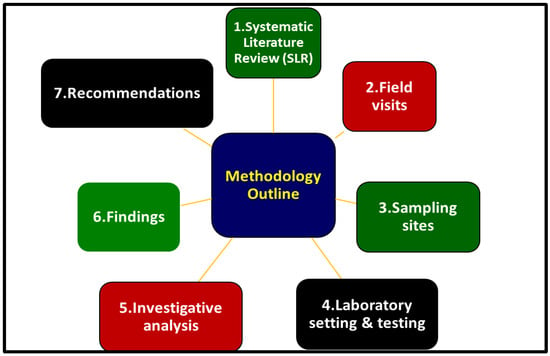
Figure 4.
Outline Concepts of Materials and Methods.
2.1. Systematic Literature Review (SLR)
It is a structured and deliberate process for discovering, analyzing, and synthesizing current research on a particular subject. The procedure generally commences with the formulation of a precise research question or objective, followed by the creation of a protocol that delineates inclusion and exclusion criteria, search methodologies, and data extraction techniques. Relevant research is located via exhaustive searches of academic databases. Subsequently, selected studies undergo a comprehensive appraisal for quality and relevance. The findings are ultimately synthesized for an evidence-based summary of previous research and the available literature. The SLR facilitated the examination of the current data regarding water status in Pakistan. Beginning with 123 shortlisted papers, they were further evaluated and reduced to 67, out of which 35 appeared to be relevant to climate change and water security in Pakistan and Baluchistan, which have been included in the study and appropriately referenced. The limitation of very little literature, specifically on Baluchistan, was obvious. The literature review is presented in the study after the introduction paragraph.
2.2. Study Area
Baluchistan province comprises thirty administrative districts and seven divisions, encompassing both A areas (where the police have jurisdiction) and B areas (jurisdiction of law enforcing agencies other than the police). The government’s processes are segmented between the police and other law enforcement entities, each possessing distinct levels of jurisdiction and involvement. Ethnically, the northern territory is populated by the Pashtuns, and the southern portion is occupied by the Baluchis. The capital city of Quetta and its environs comprise a broad array of ethnic groups. The capital city is relatively developed, featuring significant infrastructure, government edifices, military training facilities, and shopping centers. In the overall national context, geographically, Baluchistan is Pakistan’s biggest province, but from an HDI and infrastructure point of view, it is lagging in all the provinces. Figure 5 contains Baluchistan’s geographical regions.
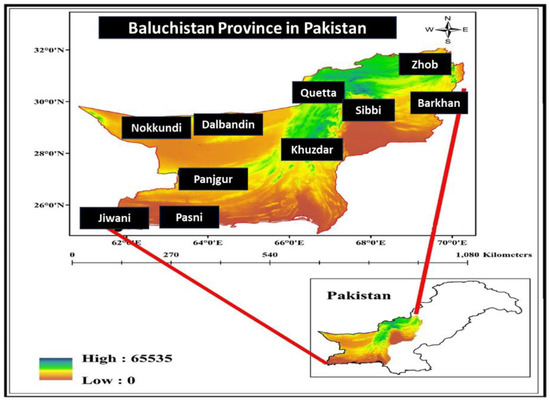
Figure 5.
Geographical Regions of Baluchistan.
2.3. Water Sampling Sites Selection Process
Water sampling sites were selected with the utmost care to ensure that the samples collected would contribute to the purpose of the study, which was to assess the water quality status in Baluchistan. The drinking water points represented the water from the source, treatment facilities, and distribution system. For industrial water in Quetta, the focus was on discharge points, effluent treatment plants, and mixing zones. For environmental assessment, samples from upstream, downstream, and at potential contamination sources (e.g., agricultural runoff) were collected. The following points were given due attention:
- Source water: Rivers, lakes, reservoirs, or groundwater wells before treatment.
- Treatment facilities: Before and after major treatment stages (e.g., filtration, chlorination).
- Distribution system: Dead-end pipes, low-pressure zones, and storage tanks.
- Points of use: Household taps, industrial discharge points, or irrigation channels.
- Water flow and mixing conditions: Samples collection was conducted where water was well-mixed to ensure consistency. Stagnant zones were avoided unless local contamination risks were assessed. Flow velocity and turbulence were considered to prevent the settling of particulates before sampling.
- Potential contamination sources: In urban areas, these included proximity to sewage discharge, industrial effluents, or stormwater drains. In agricultural zones, fertilizers, pesticides, and livestock waste were included. In industrial areas and groundwater wells, heavy metals, organic pollutants, and chemical discharges were included, considering depth, casing integrity, and pumping conditions to prevent cross-contamination.
- Special considerations for other contaminants: To detect heavy metals and pesticides, samples from areas with suspected contamination (e.g., industrial zones and agricultural lands) were taken. To determine the presence of microbiological contaminants (E. coli, Coliforms), samples from drinking water sources, storage tanks, and distribution endpoints were taken. For turbidity and sediments, the samples were collected from surface water bodies with varying depths to assess sediment distribution.
For representative sampling results, the water samples were collected from rural and urban regions for a comprehensive analysis of water quality in Baluchistan for subsequent examination and laboratory tests. Eighteen places were designated for sample collection and analysis, as given in Figure 6. The laboratory testing was executed at zone centers, and later, the results were compiled at the province level.
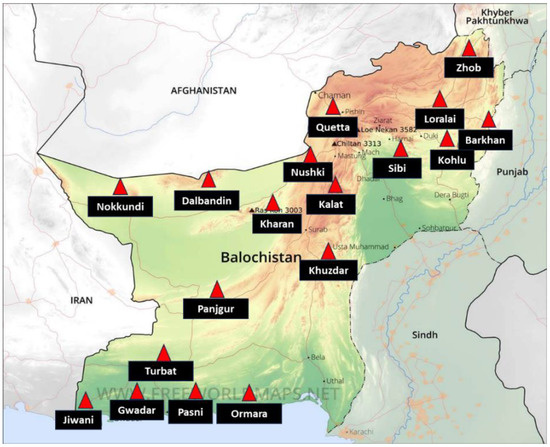
Figure 6.
Water Sampling Sites in Baluchistan.
2.4. Sampling Considerations and Methods
Sample containers: Glass vials were used for organic substances (e.g., insecticides, volatile organic compounds). Plastic bottles were used for general characteristics (e.g., pH, turbidity, nitrates). Aseptic containers were used for microbiological analysis.
Preservation and holding time: For pH and dissolved oxygen (DO), analysis was conducted without delay. Microbial samples were preserved at 4 °C, and analysis was conducted within 6 to 24 h. For metals and nutrients, preservatives such as nitric acid (HNO3) and sulfuric acid (H2SO4) were incorporated.
Sample depth: The samples from the surface were obtained from 10 to 30 cm beneath the surface. Groundwater samples were collected from monitoring wells at various depths.
The following sampling methods were considered for undertaking the study:
Grab sampling (spot sampling): Solitary specimens were obtained at a designated time and place and appropriated for evaluating factors that remain relatively stable over time (e.g., heavy metals, pH, or microbiological contamination). This was frequently utilized for potable water and regular assessment.
Composite sampling: Several grab samples were obtained over a duration and amalgamated to provide a singular representative sample. This was utilized to analyze temporal variations in contaminants, including industrial effluents and wastewater.
Automatic Sampling: Automatic samplers designed to gather grab or composite samples were employed. This was beneficial for ongoing monitoring in industrial or wastewater treatment facilities.
Passive sampling: Devices, such as diffusion samplers, were submerged in water for a designated duration to capture contaminants. This was typically utilized for the longitudinal monitoring of trace organic contaminants and metals.
2.5. Ensuring Reliability of Laboratory Testing Equipment for Water Quality Analysis
The implementation of calibration techniques, duplicate sampling, interlaboratory validation, and stringent quality measures enable laboratories to guarantee high data reliability in water quality testing. The following measures helped in meeting the above-stated benchmarks: Calibration: Routine calibration involved instruments like pH meters, spectrophotometers, and turbidity meters in accordance with manufacturer specifications given for each of these. Certified reference materials (CRM) and standards traceable to the National Institute of Standards and Technology (NIST) were used. To ensure the instrument’s linearity, zero-point and full-scale calibration was conducted as a regular undertaking. Sensor and electrode maintenance: Regular cleaning and replacement of sensors (e.g., pH electrodes and dissolved oxygen probes) was ensured according to the established protocols. Redundant sampling and repetitive analysis: It implies conducting numerous analyses on identical samples to ensure consistency of results. Duplicate sampling involves the collection and examination of two or more samples from the same site under uniform conditions. This assisted in identifying variability arising from sample handling or instrument discrepancies. Similarly, replicate analysis involved conducting several analyses of identical samples within the same laboratory to evaluate precision. Blank samples (e.g., deionized water) were used to identify contamination from apparatus, reagents, or procedural handling.
Interlaboratory validation: Comparative analysis with different laboratories guarantees external validation of findings. The following guidelines were adhered to in this regard: Proficiency testing (PT): Engaged in interlaboratory comparison initiatives (e.g., ISO 17043 [30], EPA’s Water Proficiency Testing Program) [31]. Interlaboratory comparisons: Distributed similar samples to other accredited laboratories to evaluate results and identify systematic biases, if any. Analysis of reference materials: Evaluated against the verified reference materials to verify measurement precision during all the laboratory testing processes.
2.6. Laboratory Examination and Water Quality Analysis
The laboratory examination of water samples involved the division of sampling areas and sites into geographical zones, as given in Figure 7, for administrative convenience and homogeneity of regions. This was succeeded by the creation of a network of monitoring stations, determination of sample frequency, design of sampling protocols, laboratory analysis, and documentation of the water quality status in each zone.
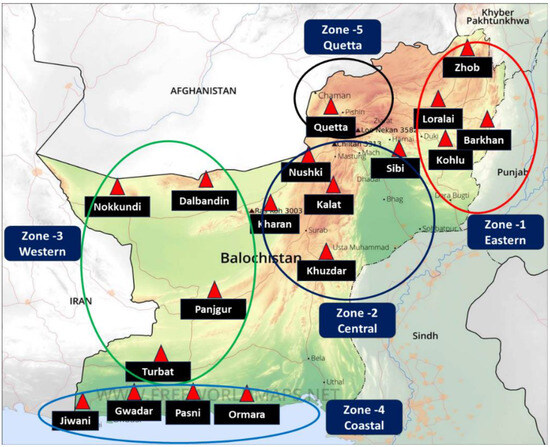
Figure 7.
Zonal Distribution of Sampling Sites.
A three-step method was utilized in the laboratory assessment to determine water quality [32]. The microbiological examination aimed at determining the level of pathogens, the physical examination to determine turbidity level, and the chemical examination to investigate mineral pollutants, pH, and phosphate. The results were later compared with water quality guidelines set out by the National Quality Standard (NQS) framework [33] and World Health Organization (WHO) guidelines for drinking water [17] in Pakistan. The subsequent paragraphs explain the three-step laboratory testing procedure.
2.7. Physical Examination
As indicated in Figure 8, the physical examination includes evaluating physical attributes that affect water’s usability and safety. Essential factors encompass color, odor, flavor, turbidity, temperature, and total dissolved solids (TDS). Turbidity, quantified in nephelometric turbidity units (NTU), signifies the existence of suspended particles that may contain pathogenic bacteria. Temperature influences gas solubility and the behavior of aquatic species, whereas TDS denotes the concentration of dissolved minerals and salts. These physical tests offer crucial insights into water quality, directing subsequent chemical and microbiological investigations to guarantee adherence to environmental and health regulations.
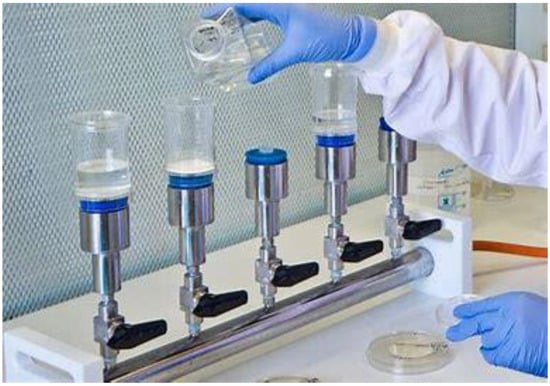
Figure 8.
Water Samples for Physical Examination.
2.8. Microbiological Examination
The microbiological analysis of water quality is essential for evaluating the existence of pathogenic microorganisms that may cause health hazards, as indicated in Figure 9. This testing entails the detection and quantification of bacteria, viruses, and protozoa, primarily concentrating on indicator species such as Escherichia coli (E. coli), coliform bacteria, and enterococci, which indicate potential fecal contamination. Conventional procedures encompass membrane filtering, multiple-tube fermentation, and molecular technologies such as PCR for the identification of specific microbial DNA. The results indicate the safety of potable water and mitigating waterborne infections. Water samples were collected in sanitized 200 mL plastic bottles, and special care was taken to avert any contamination. The samples were collected from taps that had no leaking at the spindle and gland to prevent external contamination. The samples were transported to the laboratory at a regulated temperature (20 °C to 8 °C) in suitable lightproof and sterile insulated containers. Water samples containing chlorine residues were treated with sodium thiosulfate to neutralize the residual chlorine.
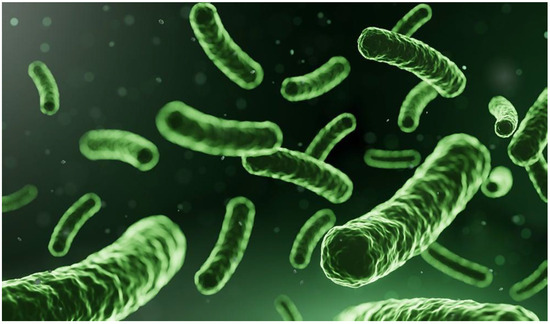
Figure 9.
Microbiological Examination for Bacteria Detection.
2.9. Chemical Examination
As indicated in Figure 10, the chemical analysis of water quality testing involved evaluating the concentration of several chemical compounds to determine water safety and adherence to regulatory norms. Testing for several chemical characteristics is necessary to identify pollutants and evaluate their concentrations in water. Commonly assessed chemical characteristics encompass ammonia, chloride ions, nitrite, nitrate, phosphate, and water hardness. The quantity of chloride ions in water might signify pollution levels and the possible existence of saline water. Elevated chloride ion concentrations can result in a saline flavor in water and may induce corrosion in water pipelines. These adversely impact water quality and may also result in increased maintenance expenses. Ammonia is frequently a result of the decomposition of organic matter and is commonly present in water sources. Ammonia levels rise with the application of chloramine in water disinfection methods. Elevated concentrations of ammonia in potable water can result in detrimental health consequences. Nitrite and nitrate are nitrogen compounds present in water as a result of organic matter decomposition and atmospheric nitrogen fixation. Nitrite can be hazardous, particularly at elevated amounts, and may lead to health complications such as “blue baby syndrome” in infants. Nitrate, conversely, promotes the proliferation of aquatic vegetation and can lead to eutrophication in natural water bodies, resulting in excessive plant growth in ponds and lakes. Phosphate exists in water in multiple forms, including dihydrogen phosphate (H2PO4−), polyphosphate (polyP), and organic phosphate. Phosphate primarily originates from agricultural waste, sewage, and industrial effluents. Although phosphate is not inherently hazardous, elevated quantities can result in water eutrophication. Water hardness denotes the concentration of calcium and magnesium salts in water. Temporary hardness results from the presence of carbonate and bicarbonate ions, whereas permanent hardness is attributed to chloride and sulfate ions. Hard water may offer specific advantages for consumption. However, elevated concentrations of particular ions can lead to undesirable scale accumulation. The testing process involved the assessment of pH levels, dissolved oxygen (DO), hardness, alkalinity, heavy metals (including lead, arsenic, and mercury), nitrates, phosphates, and additional possible pollutants. Consistent chemical analysis guarantees that water is safe for drinking, industrial applications, and environmental sustainability. Water samples were collected in 0.5-L and 1.5-L polystyrene containers. Before sample collection, the bottles underwent thorough washing and rinsing. Sampling vials used preservatives such as nitric acid (HNO) and boric acid for trace identifying elements and nitrate nitrogen. A total of 2 mL of nitric acid per liter was employed as a preservative for trace elements, whilst 1 mL of boric acid per 100 mL functioned as a preservative. The samples collected for chemical analysis were transported to the laboratory without refrigeration. A pH meter was employed for pH analysis after calibration in a water sample, and the measurement was recorded on the form.
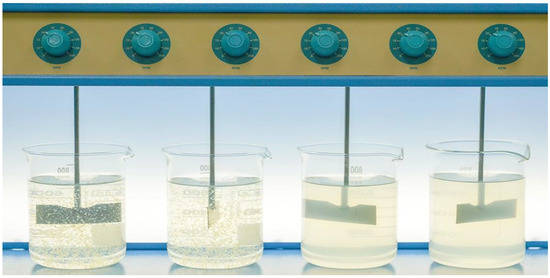
Figure 10.
Chemical Concentration Analysis.
2.10. Supplementary Factors Considered During Investigation
Rust-free taps were identified for sample collection from water filtration plants and water supply taps. Tube wells were running for 10 min to obtain true groundwater without any remnants. Hand pumps were purged several times, keeping a yardstick of one stroke for each foot of depth. For samples from streams, special care was taken to place the bottle well in the middle of the water to avoid surface contamination. Every sample form had specific information, including ID, location GPS coordinates, collection date and time, and any other special information needed. Table 1 shows the types of different samples used in the study.

Table 1.
Sampling prerequisites and process.
Table 2 presents the specifics of the sample design. The grid sizes criteria are 15 and 25 km² for large cities, 5 and 14 km2 for medium cities, and 1 km² for small cities. Each monitoring station was 1–2 km apart. Sample designation contained four types for analysis: A for bacterial, B for trace elements, C for nitrate (N), and D for additional attributes of water, if any.

Table 2.
Sampling design.
The specifics of samples gathered from rural and urban regions of each zone are presented in Table 3. The process was spread over the entire year of 2024, with the assistance of the civil administration of Baluchistan, who facilitated the establishment of observation centers and sampling sites.

Table 3.
Zonal sites for laboratory water testing.
The samples underwent extensive laboratory testing in two phases. Phase 1 was from January to June 2024, while Phase 2 was undertaken from September to November 2024. The purpose was to examine the water quality of Baluchistan during all four seasons. The results were subsequently compared with standard factors given in Table 4 for bacteriological, aesthetic, and physicochemical characteristics. The testing parameters have been taken from NQS Pakistan’s guidelines for water quality testing [34].

Table 4.
Standard parameters for water quality examination.
The water quality was assessed against the permitted limits for drinking water indicated in Table 5 [34]. The acronyms presented in the table are elucidated herein. NGVS—No Guidance Value Set, CFU—Colony Forming Unit, TCU—Total Color Units, NTU—Turbidity Unit. Table 6 and Table 7 indicate risk factors and contamination ranges.

Table 5.
Assessment thresholds for potable water.

Table 6.
Guidelines for risk analysis.

Table 7.
Contamination range parameters.
3. Results and Discussion
The water infrastructure in Pakistan consists of an intricate system of water sources, conveyance networks, treatment facilities, and distribution systems that cater to home, agricultural, and industrial requirements. Essential components encompass surface water sources (rivers, lakes, and reservoirs), groundwater extraction via wells and boreholes, and a comprehensive system of canals and pipelines for water transportation. Water infrastructure employs several materials, including steel, ductile iron, and high-density polyethylene (HDPE) for pipelines, as well as reinforced concrete for reservoirs and treatment facilities. Water treatment facilities, comprising filtration and chlorination plants, reverse osmosis systems, and desalination units, provide safe drinking water, especially in urban and water-scarce regions. In Baluchistan, where water scarcity poses substantial concerns, desalination facilities in coastal areas such as Gwadar and rainwater collection initiatives are essential. The province depends on groundwater extraction, small-scale water treatment facilities, and canal irrigation for agricultural purposes. Infrastructure maintenance frequently faces obstacles due to aged systems, insufficient investment, and climate-related phenomena such as droughts and flooding. Ongoing efforts aim to enhance water management via integrated resource strategies, restoration of supply networks, and expansion of wastewater treatment facilities to guarantee long-term water security. As a result of the exhaustive laboratory testing process, the quality of drinking water in Baluchistan also needs immediate attention, which is fast depleting.
Medium to high levels of contamination were observed during laboratory investigations from the samples collected from all geographical zones of Baluchistan, posing health risks and obstructing the achievement of UNSDG number 6 by 2030. A range of efforts have been made to guarantee the availability of potable water for the inhabitants of Baluchistan and sustainable water security. The zone-wise results of water sample testing are presented in the following paragraphs.
3.1. Zone 1 (Eastern Zone)
Zone 1 represents the Loralai, Zhob, Barkhan, and Kohlu districts. Population-wise, it is densely populated with a developed infrastructure. It is served with different modes of water supply, including springs, river streams, tube wells, hand pumps, and water supply schemes. Water samples were collected from 121 sample sites for laboratory examinations of water quality. The results indicate the presence of arsenic, turbidity, iron, TDS, E. coli, and bacteria. In total, 40% of the samples were contaminated, while 60% were classified as acceptable for consumption. The results are presented in Table 8.

Table 8.
Zone 1 Water Quality Results.
3.2. Zone 2 (Central)
Zone 2 represents the Sibbi, Nushki, Kalat, Kharan, and Khuzdar districts. In this investigation, 86 samples underwent laboratory testing. In total, 58% of the water is contaminated with coliforms, arsenic, E. coli, total dissolved solids (TDS), and iron and dangerous for drinking, while 42% were classified as suitable for consumption. Table 9 presents the water testing results for zone 2.

Table 9.
Zone 2 Water Quality Results.
3.3. Zone 3 (Western)
Zone 3 represents the Panjgur, Dalbadin, Nokkundi, and Turbat districts. In this investigation, 83 samples underwent laboratory testing. In total, 61% of the water is contaminated with coliforms, arsenic, E. coli, total dissolved solids, and iron, while 39% is deemed acceptable for consumption. Table 10 presents the water testing findings of zone 3.

Table 10.
Zone 3 Water Quality Result.
3.4. Zone 4 (Coastal)
Zone 4 represents the coastal areas of Jiwani, Gwadar, Pasni, and Ormara. In this examination, 103 samples underwent laboratory testing. About 50% of the water is contaminated with coliforms, arsenic, E. coli, total dissolved solids, turbidity, and iron, and the remaining 50% is deemed suitable for consumption. Table 11 presents the water testing findings for Zone 4.

Table 11.
Zone 4 Water Quality Results.
3.5. Zone 5 (Quetta)
Zone 5 represents Quetta’s urban center, which is also the capital of Baluchistan, with a large population and well-developed infrastructure. In this investigation, 206 samples underwent laboratory testing. In total, 43% of the water is contaminated with coliforms, arsenic, E. coli, total dissolved solids, turbidity, fluoride, and iron, while 57% is deemed acceptable for consumption. Table 12 presents the water testing findings for Zone 5.

Table 12.
Zone 5 Water Quality Results.
The laboratory test findings from five zones across the province of Baluchistan, encompassing both rural and urban centers, suggest that the water quality risk ranges from high to medium. Zones 2 and 3 exhibit high levels of contamination, while Zones 1, 4, and 5 display moderate contamination, as illustrated in Figure 11.
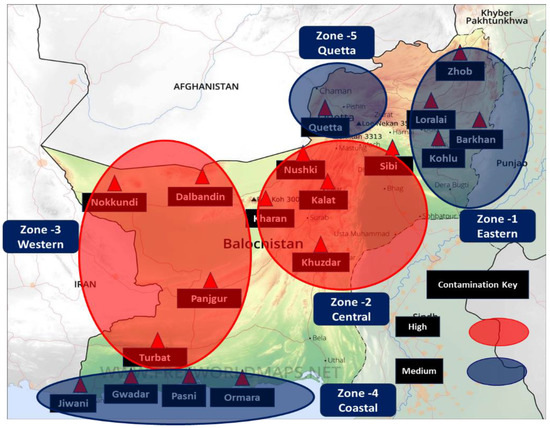
Figure 11.
Zone-wise Water Contamination Grades.
3.6. Sources of Water Contamination in Baluchistan
Water contamination constitutes a significant challenge in Baluchistan, where the arid climate and scarce water resources intensify the issue. The region has a complex water problem stemming from both natural and human-induced factors. The causes can be classified as over-extraction, agricultural and industrial practices, inadequate infrastructure, and natural contamination, all of which provide significant dangers to the health and livelihoods of locals. The over-extraction of groundwater is a primary contributor to water contamination in Baluchistan, as the region relies heavily on groundwater. The excessive exploitation of groundwater has led to a significant decrease in the water table and encroachment of salty water into freshwater aquifers, rendering it unfit for consumption or irrigation. In coastal regions, the incursion of seawater into aquifers has intensified the salinity problems. Agriculture constitutes the backbone of Baluchistan’s economy, but redundant farming practices have led to water pollution. The overuse of chemical fertilizers and pesticides infiltrates water sources via runoff, especially during rainfall. This runoff pollutes both surface and groundwater with nitrates, phosphates, and hazardous compounds. These pollutants not only degrade water quality but also adversely affect aquatic ecosystems and render the water unfit for human consumption. Additionally, animal waste from livestock agriculture frequently contaminates water sources, introducing pathogens and organic debris that compromise water safety. Industrialization and mining operations in Baluchistan, however restricted, constitute a notable source of water pollution. Mining activities for coal, copper, and other minerals frequently discharge deleterious compounds, including heavy metals (lead, arsenic, and mercury) and acid mine drainage, into adjacent water bodies. These pollutants are extremely hazardous and remain in the environment for extended durations. Inadequate wastewater treatment facilities also contribute to water pollution in Baluchistan. Urban regions are deficient in adequate sewage infrastructure, resulting in untreated effluent from residential and commercial sources being frequently released directly into natural water bodies. This effluent comprises a combination of biological and chemical contaminants. In rural regions, open defecation and inadequate sanitation practices exacerbate water quality by contaminating drinking water sources with fecal matter and pathogens. The improper disposal of solid waste, encompassing plastics, dangerous substances, and medical refuse, is a notable contributor to water contamination. Disposing of waste in or adjacent to water bodies, like streams and canals, results in the seeping of detrimental chemicals into the water. The absence of waste management systems exacerbates this issue, especially in urban areas such as Quetta, where population density is significant. Specific regions of Baluchistan are impacted by contamination from natural water sources. These toxins emanate from geological formations and are discharged into the water by natural processes. Prolonged ingestion of water with high arsenic concentrations can result in severe health issues, such as cancer, dermal sores, and cardiovascular disorders. Excessive fluoride concentrations induce dental and skeletal problems, particularly impacting children.
Baluchistan’s arid climate makes it particularly vulnerable to climate change, which also intensifies water contamination issues. Unpredictable rainfall patterns increase the likelihood of flash floods, which wash contaminants from the land into water bodies. Climate change further exacerbates salinity problems in coastal areas due to rising sea levels and seawater intrusion. The lack of a comprehensive water quality monitoring system in Baluchistan is a critical barrier to addressing water contamination challenges. Limited testing facilities and weak regulatory enforcement allow industries, farmers, and households to discharge pollutants into water sources without accountability. Many residents rely on untreated water for drinking and domestic purposes, unaware of its contamination levels. This lack of oversight perpetuates the cycle of pollution and poses significant risks to public health. The deterioration and inadequate maintenance of water supply infrastructure contribute to water contamination. Leaking pipelines and exposed storage tanks facilitate the infiltration of contaminants, including dust, bacteria, and chemicals, into the water supply. Insufficient safeguarding of wells and boreholes renders them vulnerable to pollution from surface runoff and anthropogenic activities.
3.7. Water Scarcity in Baluchistan
In 1947, per capita, 5600 cubic meters were available in Pakistan, but this number has steadily declined [35] to 5260 cubic meters in 1951 and 1038 cubic meters in 2010. This forecast indicates that by 2025, it will further shrink to 877 cubic meters, and by 2050, it will decline to 575 cubic meters per annum [4]. Figure 12 illustrates the anticipated per capita reduction in water from 1951 to 2050.

Figure 12.
Projected water decline in 2050.
Water scarcity in Baluchistan is a significant and complex issue, fundamentally linked to the province’s arid climate, mismanagement of water resources, demographic pressures, and socio-economic weaknesses. This persistent dilemma endangers both the livelihoods of the local populace and the province’s delicate ecological and economic stability. The region’s average annual precipitation significantly lags below the national average, inadequate to satisfy the increasing water requirements of its populace, agriculture, and limited industrial usage. Climate change has exacerbated variability in precipitation and a greater frequency of extreme weather events, including flash floods and extended droughts, thereby upsetting conventional water supply patterns. Groundwater constitutes the principal water supply in Baluchistan due to the scarcity of surface water. Nonetheless, unsustainable extraction methods have resulted in the swift depletion of aquifers. The extensive utilization of tube wells for agricultural and domestic applications has resulted in a significant decline in groundwater levels throughout the province. Inefficient water management strategies and antiquated infrastructure substantially exacerbate water scarcity. Inadequately maintained irrigation systems lead to significant water losses from leakage and evaporation. Insufficient storage capacity for rainwater compounds the issue, resulting in a substantial amount of seasonal rainfall being lost as runoff. The lack of contemporary irrigation methods, like drip and sprinkler systems, exacerbates the problem, rendering agriculture a significant factor in water scarcity. Urban cities like Quetta are experiencing increasing pressure to satisfy the demands of their expanding population, resulting in excessive dependence on finite groundwater resources. Moreover, insufficient design for urban water supply and distribution systems exacerbates the existing limitations of water infrastructure.
Despite the existence of national water management policies, their implementation in Baluchistan is handicapped by inadequate institutional capacity and weak governance. The water scarcity is also compounded by transboundary water concerns with adjacent provinces. Conflicts regarding the allocation of river water, including the Indus River and its tributaries, pose difficulties in guaranteeing a reliable and equitable water supply to Baluchistan. The province’s dependence on upstream areas for water supply renders it susceptible to alterations in water allocation rules or the construction of dams and barrages by adjacent regions, exacerbating its already constrained supplies.
The reasons for water scarcity in Baluchistan are intricately linked, arising from a blend of natural and anthropogenic forces. The province’s arid climate, excessive dependence on groundwater, inadequate water management, ineffective agricultural techniques, and the effects of climate change all exacerbate the escalating water crisis.
3.8. Water Quality Monitoring and Testing Mechanism in Pakistan and Baluchistan
Water quality monitoring and testing in Pakistan, including Baluchistan, is performed by a consortium of governmental agencies, research institutes, and independent groups to evaluate the quality of drinking water, surface water, and groundwater. The Pakistan Council of Research in Water Resources (PCRWR) is the principal organization mandated to conduct national water quality examinations and regular analyses for pollutants, including heavy metals, bacteria, nitrates, fluoride, and arsenic. Provincial Environmental Protection Agencies (EPAs) regulate water quality, especially in urban and industrial regions. Water quality monitoring in Baluchistan encounters obstacles due to insufficient testing facilities, groundwater depletion, and contamination from natural sources, including arsenic and fluoride. Testing methodologies encompass physicochemical analysis, microbiological assessment, and heavy metal identification. Nonetheless, insufficient laboratory equipment and irregular monitoring in rural areas impede effective supervision. Initiatives are underway to enhance water quality monitoring via mobile testing units, enhanced laboratory networks, and more stringent industrial wastewater regulations to guarantee safer drinking water and environmental safeguarding in Baluchistan.
4. Recommendations for Ensuring Water Security in Baluchistan
The year 2025 marks the beginning of Pakistan’s water scarcity line, which warrants immediate attention by all the policy-making organizations as an evolving national security issue hampering the achievement of UNSDG number 6 related to water security by the year 2030. Figure 13 indicates the diagrammatic layout of thrust lines to ensure water quality and water security in Baluchistan, which are explained in subsequent paragraphs.
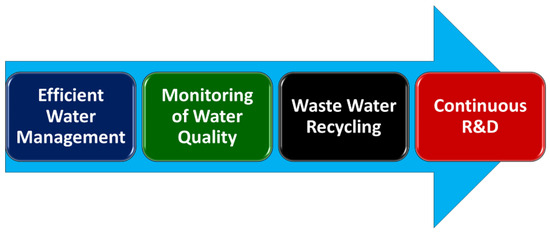
Figure 13.
Recommendations thrust lines.
4.1. Water Management, Conservation and Distribution
Water scarcity during the harvesting season presents a substantial challenge in Pakistan, resulting in conflicts between the federation and the provinces. The Council of Common Interest and the 1991 water accord aimed to resolve issues about water allocation; nevertheless, inadequate management, ineffective governance, and perceptual discrepancies between the federation and provinces present substantial challenges. A thorough governmental strategy is recommended, supplemented by onsite consultations from provincial and federal officials, along with political leaders, to cultivate consensus and improve understanding of the complexities involved in the judicious and inclusive use of current water resources. Pakistan Water Apportionment Accord 1991 needs a full understanding and implementation. Despite the establishment of the Indus River System Authority (IRSA) in 1992 to oversee water governance and management issues between provinces and federations, the implementation and onsite coordination need better consultations in the future. The eighteenth constitutional amendment classified water distribution between rural and urban regions within each province as an internal provincial matter.
The Baluchistan administration should advocate for the collection and storage of rainwater via rooftop harvesting systems, communal tanks, and surface reservoirs to optimize the utilization of seasonal precipitation. This can be achieved by promoting the implementation of contemporary irrigation methods, including drip irrigation, sprinkler systems, and laser land leveling, to minimize water wastage in agriculture. The district administrations must restore and sustain the ancient Karez irrigation system to guarantee effective water distribution and replenish groundwater while also implementing educational initiatives to enhance public awareness regarding water conservation. It is recommended that rules be implemented to oversee and regulate the excessive extraction of groundwater, including licensing for tube wells and establishing usage limits. It is essential to establish systems for the treatment and reuse of wastewater for non-potable applications, including irrigation, industrial processes, and sanitation. The following steps are also advised: Promoting the cultivation of fewer water-intensive crops that are more appropriate for Baluchistan’s arid climate; Implementing water-efficient fixtures, including low-flow faucets, dual-flush toilets, and intelligent irrigation systems in residential, industrial, and public environments; Constructing small and medium-sized dams, water reservoirs, and check dams to capture runoff and mitigate evaporation; Preserving and rehabilitating watersheds, wetlands, and woodlands to enhance natural water retention and diminish surface runoff; Engaging local communities in water conservation projects, empowering them to manage and distribute water resources fairly, while repairing leaking pipelines, tanks, and taps to reduce water loss in urban and rural supply systems; Conducting water audits for selected industries, agriculture, and public utilities to pinpoint inefficiencies and enhance water utilization techniques.
4.2. Water Quality Monitoring Mechanism
The monitoring of water quality at regular intervals is the need of time. The government has already established the Pakistan Council of Research in Water Resources (PCRWR), which is mandated to ensure potable water across Pakistan. A water quality monitoring system is an apparatus employed to assess chlorine concentrations, suspended solids, pH levels, total ionic strength, and oxygen-reduction potential in water, among other metrics. A variety of sensors are utilized for detection, including residual chlorine sensor, total organic carbon (TOC) sensor, turbidity sensor, conductivity sensor, pH sensor, and oxygen-reduction potential (ORP) sensor, among others. On 20 October 2021, the “National Water Quality Monitoring Program” was initiated to analyze and evaluate drinking water issues across Pakistan. To meet the 6.1 target set by the UN Sustainable Development Goals, Pakistan must quadruple its efforts to improve water quality. Twenty-four testing laboratories have been established by PCRWR that operate continuously across Pakistan, diligently working to improve the national water quality system. A proposal is made for the process and capacity enhancement of PCRWR, including the establishment of offices and laboratories nationwide, particularly in the undeveloped regions of Baluchistan. The government of Baluchistan should establish community-level water filtration plants in rural and urban areas to remove contaminants such as salinity, arsenic, and other pollutants; Distribute low-cost household water purification solutions, such as ceramic filters, chlorination tablets, and portable filtration systems, to underserved communities; Repair and upgrade existing water supply networks, pipelines, and storage tanks to prevent leaks and contamination; Ensure proper sanitation around water sources; Implement wastewater management systems to prevent the contamination of natural water sources; Establish wastewater treatment facilities in urban and semi-urban areas; Safeguard natural springs and aquifers from pollution and over-extraction; Establish buffer zones around water sources and regulate industrial or agricultural activities near them; Set up solar-powered water kiosks in remote areas to provide filtered drinking water to communities; Regularly test water sources for contaminants and publish data to ensure accountability; Equip local health departments with tools and training for water quality monitoring; Conduct awareness campaigns on the importance of hygiene and safe water handling, including storing drinking water in clean containers and boiling water when necessary.
4.3. Recycling of Wastewater
The Baluchistan government can utilize the right installation of treatment plants to purify sewage or wastewater, enabling its usage for irrigation, washing, and cleaning purposes. The Bahria town, a private housing society in Pakistan, has installed such treatment plants in its housing projects across provinces, which can help replicate such efforts by the government in Baluchistan.
4.4. Continuous Research and Development (R&D)
By 2025, all available research data from multiple sources indicate that Pakistan has reached the water-scarce line. It is about time that we declare a water emergency in Pakistan and take all measures to provide quality drinking water and ensure water security on a sustainable basis. All the universities and research organizations should be geared on a war footing to create a research platform focusing on multidimensional research ranging from water quality to regulation, distribution, and management. All previous research and archival data should immediately be shared with PCWR, the Ministry of Water and Power and Planning Commission, and the provincial governments to implement water security measures immediately. Future research should also focus on the long-term sustainability of water security in order for Pakistan to achieve UNSDG number 6 by 2030.
5. Conclusions
Water scarcity and quality are pressing concerns in Baluchistan, necessitating immediate and comprehensive solutions. Addressing these challenges in Baluchistan necessitates a holistic strategy that incorporates sustainable water management, infrastructure enhancement, and community involvement. Improving rainwater gathering and constructing tiny check dams can substantially enhance water storage and groundwater replenishment. Upgrading irrigation infrastructure and advocating for smart farming practices can minimize water wastage while sustaining productivity. Investments in wastewater treatment facilities and the enforcement of rigorous regulations to mitigate industrial and agricultural pollution are essential for maintaining water quality. Ensuring water security and enhancing water quality in Baluchistan is essential for the province’s sustained development and the welfare of its inhabitants. Cooperative initiatives among the government, local communities, and foreign organizations can facilitate a future in which access to clean and adequate water is attainable for all inhabitants of Baluchistan. This study is expected to serve as a policy input for the relevant government ministries of Baluchistan in addressing the imminent human security and national security challenges while significantly contributing to the achievement of water-related UNSDGs.
Author Contributions
W.I.: Conceptualization, methodology, software, visualization, validation, investigation Supervision, and writing initial draft; M.Z.u.R.: Visualization, supervision, data curation, writing, editing, formal analysis, administration. All authors have read and agreed to the published version of the manuscript.
Funding
This research received no external funding.
Institutional Review Board Statement
The study has been approved by the Ethics Committee of the National University of Modern Languages (NUML), Islamabad, vide letter number ML-R&SI/3743, dated 30 December 2024.
Informed Consent Statement
Not applicable.
Data Availability Statement
The author declares that the data and empirical analyses supporting the findings of this research article are available within this article in the form of figures and tables.
Conflicts of Interest
The authors declare no conflict of interest.
References
- Sustainable Development Goals (SDG 6) United Nations Western Europe. Available online: https://unric.org/en/sdg-6/ (accessed on 18 February 2025).
- World Bank. The World Bank Data; World Bank: Washington, DC, USA, 2019; Available online: https://data.worldbank.org/ (accessed on 24 January 2018).
- UN Habitat. Pakistan Country Report. 2023. UN-Habitat. Available online: https://unhabitat.org/sites/default/files/2023/06/4._pakistan_country_report_2023_b5_final_compressed.pdf (accessed on 31 December 2023).
- Daud, M.K.; Nafees, M.; Ali, S.; Rizwan, M.; Bajwa, R.A.; Shakoor, M.B.; Arshad, M.U.; Chatha, S.A.S.; Deeba, F.; Murad, W.; et al. Drinking Water Quality Status and Contamination in Pakistan. BioMed Res. Int. 2017, 1, 7908183. [Google Scholar] [CrossRef] [PubMed]
- Azizullah, A.; Khattak, M.N.K.; Richter, P.; Häder, D.-P. Water pollution in Pakistan and its impact on public health—A review. Environ. Int. 2011, 37, 479–497. [Google Scholar] [CrossRef] [PubMed]
- Raza, M.; Hussain, F.; Lee, J.-Y.; Shakoor, M.B.; Kwon, K.D. Groundwater status in Pakistan: A review of contamination, health risks, and potential needs. Crit. Rev. Environ. Sci. Technol. 2017, 47, 1713–1762. [Google Scholar] [CrossRef]
- Ishaque, W.; Tanvir, R.; Mukhtar, M. Climate Change and Water Crises in Pakistan: Implications on Water Quality and Health Risks. J. Environ. Public Health 2022, 2022, 5484561. [Google Scholar] [CrossRef] [PubMed]
- Ishaque, W.; Mukhtar, M.; Tanvir, R. Pakistan’s water resource management: Ensuring water security for sustainable development. Front. Environ. Sci. 2023, 11, 1096747. [Google Scholar] [CrossRef]
- Ishaque, W.; Sultan, K.; Rehman, Z.U. Water management and sustainable development in Pakistan: Environmental and health impacts of water quality on achieving the UNSDGs by 2030. Front. Water 2024, 6, 1267164. [Google Scholar] [CrossRef]
- Climate Data Processing Centre, PMD, Pakistan. Available online: https://cdpc.pmd.gov.pk/ (accessed on 18 February 2025).
- Oksana, T.; Dmytro, G. Earth’s Water Distribution. In Clean Water and Sanitation; Springer: Berlin/Heidelberg, Germany, 2021; pp. 1–14. [Google Scholar]
- Mishra, R.K. Fresh Water Availability and Its Global Challenge. Br. J. Multidiscip. Adv. Stud. 2023, 4, 1–78. [Google Scholar] [CrossRef]
- Bashir, S.; Aslam, Z.; Niazi, N.K.; Khan, M.I.; Chen, Z. Impacts of Water Quality on Human Health in Pakistan. In Water Resources of Pakistan: Issues and Impacts; Watto, M.A., Mitchell, M., Bashir, S., Eds.; Springer International Publishing: Berlin/Heidelberg, Germany, 2021; pp. 225–247. [Google Scholar] [CrossRef]
- Fida, M.; Li, P.; Wang, Y.; Alam, S.M.K.; Nsabimana, A. Water Contamination and Human Health Risks in Pakistan: A Review. Expo. Health 2023, 15, 619–639. [Google Scholar] [CrossRef]
- Watto, M.A.; Mitchell, M.; Akhtar, T. Pakistan’s Water Resources: Overview and Challenges. In Water Resources of Pakistan: Issues and Impacts; Springer International Publishing: Berlin/Heidelberg, Germany, 2021; pp. 1–12. [Google Scholar]
- Pakistan Environmental Protection Agency. Available online: https://environment.gov.pk/Detail/MDUzMDI1OGItYWYzZC00NzQ0LTlhZWItZjYzY2RkOTkyZGVh (accessed on 18 February 2025).
- Guidelines for Drinking-Water Quality, 4th Edition, Incorporating the 1st Addendum. Available online: https://www.who.int/publications/i/item/9789241549950 (accessed on 18 February 2025).
- Ishaque, W.; Ahmed, S.M.; Hussain, I.S. Influence of Climate Change on Pakistan’s National Security. Grassroots 2015, 49, 65. [Google Scholar]
- Hussain, M.; Butt, A.R.; Uzma, F.; Ahmed, R.; Irshad, S.; Rehman, A.; Yousaf, B. A comprehensive review of climate change impacts, adaptation, and mitigation on environmental and natural calamities in Pakistan. Environ. Monit. Assess. 2019, 192, 48. [Google Scholar] [CrossRef] [PubMed]
- Fahad, S.; Wang, J. Climate change, vulnerability, and its impacts in rural Pakistan: A review. Environ. Sci. Pollut. Res. 2019, 27, 1334–1338. [Google Scholar] [CrossRef] [PubMed]
- Khan, M.A.; Khan, J.A.; Ali, Z.; Ahmad, I.; Ahmad, M.N. The challenge of climate change and policy response in Pakistan. Environ. Earth Sci. 2016, 75, 412. [Google Scholar] [CrossRef]
- Ali, S.; Liu, Y.; Ishaq, M.; Shah, T.; Abdullah, S.; Ilyas, A.; Din, I.U. Climate Change and Its Impact on the Yield of Major Food Crops: Evidence from Pakistan. Foods 2017, 6, 39. [Google Scholar] [CrossRef] [PubMed]
- Malik, S.M.; Awan, H.; Khan, N. Mapping vulnerability to climate change and its repercussions on human health in Pakistan. Glob. Health 2012, 8, 31. [Google Scholar] [CrossRef] [PubMed]
- Ahmed, T.; Scholz, M.; Al-Faraj, F.; Niaz, W. Water-Related Impacts of Climate Change on Agriculture and Subsequently on Public Health: A Review for Generalists with Particular Reference to Pakistan. Int. J. Environ. Res. Public Health 2016, 13, 1051. [Google Scholar] [CrossRef] [PubMed]
- Khan, M.A.; Tahir, A.; Khurshid, N.; Husnain, M.I.U.; Ahmed, M.; Boughanmi, H. Economic Effects of Climate Change-Induced Loss of Agricultural Production by 2050: A Case Study of Pakistan. Sustainability 2020, 12, 1216. [Google Scholar] [CrossRef]
- Saeed, A.; Ali, S.; Khan, F.; Muhammad, S.; Reboita, M.S.; Khan, A.W.; Goheer, M.A.; Khan, M.A.; Kumar, R.; Ikram, A.; et al. Modelling the impact of climate change on dengue outbreaks and future spatiotemporal shift in Pakistan. Environ. Geochem. Health 2022, 45, 3489–3505. [Google Scholar] [CrossRef] [PubMed]
- Aslam, M.N.; Ashraf, S.; Shrestha, S.; Ali, M.; Hanh, N.C. Climate change impact on water scarcity in the Hub River Basin, Pakistan. Groundw. Sustain. Dev. 2024, 27, 101339. [Google Scholar] [CrossRef]
- Baocheng, H.; Jamil, A.; Bellaoulah, M.; Mukhtar, A.; Clauvis, N.K. Impact of climate change on water scarcity in Pakistan. Implications for water management and policy. J. Water Clim. Change 2024, 15, 3602–3623. [Google Scholar] [CrossRef]
- Khan, K.A. Water Scarcity and Its Impact on the Agricultural Sector of Balochistan. J. Public Policy Pract. 2022, 1, 1–66. [Google Scholar] [CrossRef]
- Hogan, R. Proficiency Testing and Interlaboratory Comparisons: The Ultimate Guide, Isobudgets, 11 January 2019. Available online: https://www.isobudgets.com/proficiency-testing-and-interlaboratory-comparisons/ (accessed on 18 February 2025).
- OW US EPA, Certification of Laboratories That Analyze Drinking Water Samples to Ensure Compliance with Regulations Collections and Lists, 3 August 2015. Available online: https://www.epa.gov/dwlabcert (accessed on 18 February 2025).
- A Complete Guide to Water Analysis Methods in Industries, Atlas Scientific, 3 November 2023. Available online: https://atlas-scientific.com/blog/water-analysis-methods/ (accessed on 18 February 2025).
- Dil, A.S.; Qzai, I.A.; Baig, M.A.; Khan, E.A.; Tahir, A. National Standards forDrinking Water Quality (NSDWG). (Islamabad: Ministry of Environmental Protection Government of Pakistan, 30 June 2008). Available online: https://www.mocc.gov.pk/SiteImage/Misc/files/Drinking%20Water%20Quality%20Standares%20MAY%202007.pdf (accessed on 18 February 2025).
- Pakistan Council for Research in Water Resources (PCWR). 19 2025. Available online: https://www.pcrwr.gov.pk/water-quality/ (accessed on 25 December 2024).
- Islam, S. Water Availability Has Dropped 500% Since 1947. The Express Tribune. Islamabad, Pakistan. 20 June 2011. Available online: https://tribune.com.pk/story/193120/water-availability-has-dropped-500-since-194 (accessed on 1 January 2025).
Disclaimer/Publisher’s Note: The statements, opinions and data contained in all publications are solely those of the individual author(s) and contributor(s) and not of MDPI and/or the editor(s). MDPI and/or the editor(s) disclaim responsibility for any injury to people or property resulting from any ideas, methods, instructions or products referred to in the content. |
© 2025 by the authors. Licensee MDPI, Basel, Switzerland. This article is an open access article distributed under the terms and conditions of the Creative Commons Attribution (CC BY) license (https://creativecommons.org/licenses/by/4.0/).